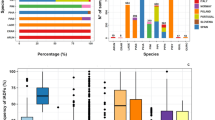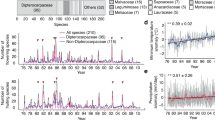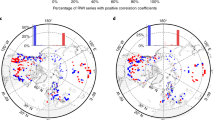Abstract
Climate forcings determine the episodic occurrence of local climate anomalies that trigger the occurrence of masting events (massive, synchronized and intermittent seed production by perennial plants). This suggests some kind of phase-locking of the reproductive cycles of individual plants to the climatological cycle, thus further reinforcing reproductive synchrony and the Moran effect. We propose a dendrochronological approach to filter out the long-term direct effects of climate on tree radial growth and temporal reproductive effort by sex by using actual trees as climatic controls to reconstruct masting events in Araucaria araucana, a long-lived dioecious masting conifer. In this way, we developed a multi-century-long tree masting reconstruction for South America using female–male radial growth determined by differences in timing and magnitude of the reproductive effort between sexes. We provide evidence for a regional synchronizing mechanism of masting which is drought induced by strong cold La Niña phases of El Niño/Southern Oscillation (ENSO) amplified by the positive phases of the Southern Annular Mode (SAM) that activate both female and male cone bud formation during year −2 before seed fall; that is, a long-term phase-locking between the ENSO cycle and the reproductive cycle modulated by the strength of SAM. In addition, our regional index of masting frequency showed its maximum during the late twentieth century relative to the previous centuries, suggesting that the species is currently at its maximum masting frequency concurrent with a period of enhanced temperature and drought conditions in Patagonia, probably driven by the positive phase of the SAM.
This is a preview of subscription content, access via your institution
Access options
Access Nature and 54 other Nature Portfolio journals
Get Nature+, our best-value online-access subscription
$29.99 / 30 days
cancel any time
Subscribe to this journal
Receive 12 digital issues and online access to articles
$119.00 per year
only $9.92 per issue
Buy this article
- Purchase on Springer Link
- Instant access to full article PDF
Prices may be subject to local taxes which are calculated during checkout







Similar content being viewed by others
Data availability
The tree-ring data that support the findings of this study are openly available in the National Centers for Environmental Information of NOAA/World Data Service for Paleoclimatology archives at https://www.ncdc.noaa.gov/data-access/paleoclimatology-data with the following reference numbers based on the corresponding sampled site: HAC (https://doi.org/10.25921/1dst-hz36), PAR (https://doi.org/10.25921/tqva-s673) and RAH (https://doi.org/10.25921/hsg7-ak15). The regional seed gathering record, cone production (number per tree) register and standardized (mean = 0 and s.d. = 1) series for the period 1988–2014 are available in Supplementary Table 5.
References
Kelly, D. The evolutionary ecology of mast seeding. Trends Ecol. Evol. 9, 465–470 (1994).
Janzen, D. H. Seed predation by animals. Annu. Rev. Ecol. Syst. 2, 465–492 (1971).
Silvertown, J. W. The evolutionary ecology of mast seeding in trees. Biol. J. Linn. Soc. 14, 235–250 (1980).
Koenig, W. D. Global patterns of environmental synchrony and the Moran effect. Ecography 25, 283–288 (2002).
Moran, P. A. P. The statistical analysis of the Canadian Lynx cycle. Aust. J. Zool. 1, 291–298 (1953).
Ranta, E., Veijo, K. & Lindströom, J. Spatially autocorrelated disturbances and patterns in population synchrony. Proc. R. Soc. Lond. B 266, 1851–1856 (1999).
Liebhold, A., Koenig, W. D. & Bjørnstad, O. N. Spatial synchrony in population dynamics. Annu. Rev. Ecol. Evol. Syst. 35, 467–490 (2004).
Sanguinetti, J. Producción y Predación de Semillas, Efectos de Corto y Largo Plazo Sobre el Reclutamiento de Plántulas. Caso de Estudio: Araucaria araucana (Universidad Nacional del Comahue, 2008).
Schauber, E. M. et al. Masting by eighteen New Zealand plant species: the role of temperature as a synchronizing cue. Ecology 83, 1214–1225 (2002).
Fletcher, M.-S. Mast seeding and the El Niño-Southern Oscillation: a long-term relationship? Plant Ecol. 216, 527–533 (2015).
Koenig, W. D. & Knops, J. M. H. Scale of mast-seeding and tree-ring growth. Nature 396, 225 (1998).
Hacket-Pain, A. J. et al. Climatically controlled reproduction drives interannual growth variability in a temperate tree species. Ecol. Lett. 21, 1833–1844 (2018).
Hadad, M. A., Roig, F. A., Arco Molina, J. G. & Hacket-Pain, A. Growth of male and female Araucaria araucana trees respond differently to regional mast events, creating sex-specific patterns in their tree-ring chronologies. Ecol. Indic. 122, 107245 (2021).
Thompson, D. W. J., Wallace, J. M. & Hegerl, G. C. Annular modes in the extratropical circulation. Part II: trends. J. Clim. 13, 1018–1036 (2000).
Holz, A., Kitzberger, T., Paritsis, J. & Veblen, T. T. Ecological and climatic controls of modern wildfire activity patterns across southwestern South America. Ecosphere 3, 1–25 (2012).
Mundo, I. A., Kitzberger, T., Roig Juñent, F. A., Villalba, R. & Barrera, M. D. Fire history in the Araucaria araucana forests of Argentina: human and climate influences. Int. J. Wildland Fire 22, 194–206 (2013).
Mundo, I. A., Roig Juñent, F. A., Villalba, R., Kitzberger, T. & Barrera, M. D. Araucaria araucana tree-ring chronologies in Argentina: spatial growth variations and climate influences. Trees-Struct. Funct. 26, 443–458 (2012).
Veblen, T. T., Kitzberger, T., Villalba, R. & Donnegan, J. Fire history in Northern Patagonia: the roles of humans and climatic variation. Ecol. Monogr. 69, 47–67 (1999).
Sanguinetti, J. & Kitzberger, T. Patterns and mechanisms of masting in the large-seeded southern hemisphere conifer Araucaria araucana. Austral Ecol. 33, 78–87 (2008).
Wigley, T. M. L., Briffa, K. & Jones, P. D. On the average value of correlated time series, with applications in dendroclimatology and hydrometeorology. J. Clim. Appl. Meteorol. 23, 201–213 (1984).
Swetnam, T. W. & Lynch, A. M. Multicentury, regional-scale patterns of Western Spruce budworm outbreaks. Ecol. Monogr. 63, 399–424 (1993).
Kitzberger, T., Veblen, T. T. & Villalba, R. Tectonic influences on tree growth in northern Patagonia, Argentina: the roles of substrate stability and climatic variation. Can. J. Res. 25, 1684–1696 (1995).
Mundo, I. A. et al. Austrocedrus chilensis growth decline in relation to drought events in northern Patagonia, Argentina. Trees Struct. Funct. 24, 561–570 (2010).
Rozas, V. et al. Climatic cues for secondary growth and cone production are sex-dependent in the long-lived dioecious conifer Araucaria araucana. Agric. Meteorol. 274, 132–143 (2019).
Pearse, I. S., Koenig, W. D. & Kelly, D. Mechanisms of mast seeding: resources, weather, cues, and selection. New Phytol. 212, 546–562 (2016).
Sanguinetti, J. & Kitzberger, T. Factors controlling seed predation by rodents and non-native Sus scrofa in Araucaria araucana forests: potential effects on seedling establishment. Biol. Invasions 12, 689–706 (2010).
Sanguinetti, J. & Kitzberger, T. Efectos de la producción de semillas y de la heterogeneidad vegetal sobre la supervivencia de semillas y el patrón espacio-temporal de establecimiento de plántulas en Araucaria araucana. Rev. Chil. Hist. Nat. 82, 319–335 (2009).
Kelly, D. et al. Of mast and mean: differential-temperature cue makes mast seeding insensitive to climate change. Ecol. Lett. 16, 90–98 (2013).
Ostfeld, R. S. & Keesing, F. Pulsed resources and community dynamics of consumers in terrestrial ecosystems. Trends Ecol. Evol. 15, 232–237 (2000).
Holmgren, M., Scheffer, M., Ezcurra, E., Gutiérrez, J. R. & Mohren, G. M. J. El Niño effects on the dynamics of terrestrial ecosystems. Trends Ecol. Evol. 16, 89–94 (2001).
Swetnam, T. W. & Betancourt, J. L. Mesoscale disturbance and ecological response to decadal climatic variability in the American southwest. J. Clim. 11, 3128–3147 (1998).
Kitzberger, T., Swetnam, T. W. & Veblen, T. T. Inter-hemispheric synchrony of forest fires and the El Niño-Southern Oscillation. Glob. Ecol. Biogeogr. 10, 315–326 (2001).
Marshall, G. J. Trends in the Southern Annular Mode from observations and reanalyses. J. Clim. 16, 4134–4143 (2003).
Silvestri, G. E. & Vera, C. S. Antarctic Oscillation signal on precipitation anomalies over southeastern South America. Geophys. Res. Lett. 30, 2115 (2003).
Cai, W. et al. Climate impacts of the El Niño–Southern Oscillation on South America. Nat. Rev. Earth Environ. 1, 215–231 (2020).
Piovesan, G. & Adams, J. M. Masting behaviour in beech: linking reproduction and climatic variation. Can. J. Bot. 79, 1039–1047 (2001).
Drobyshev, I., Niklasson, M., Mazerolle, M. J. & Bergeron, Y. Reconstruction of a 253-year long mast record of European beech reveals its association with large scale temperature variability and no long-term trend in mast frequencies. Agric. Meteorol. 192–193, 9–17 (2014).
Fernández-Martínez, M., Vicca, S., Janssens, I. A., Espelta, J. M. & Peñuelas, J. The North Atlantic Oscillation synchronises fruit production in western European forests. Ecography 40, 864–874 (2017).
Ascoli, D. et al. Two centuries of masting data for European beech and Norway spruce across the European continent. Ecology 98, 1473 (2017).
Thompson, D. W. J. et al. Signatures of the Antarctic ozone hole in Southern Hemisphere surface climate change. Nat. Geosci. 4, 741–749 (2011).
Jacques-Coper, M., Brönnimann, S., Martius, O., Vera, C. & Cerne, B. Summer heat waves in southeastern Patagonia: an analysis of the intraseasonal timescale. Int. J. Climatol. 36, 1359–1374 (2016).
Estudio de la Variabilidad Climáticas en Chile para el Siglo XXI (CONAMA, 2006).
Garreaud, R. D. et al. The 2010–2015 megadrought in central Chile: impacts on regional hydroclimate and vegetation. Hydrol. Earth Syst. Sci. 21, 6307–6327 (2017).
Tortorelli, L. A. La explotación racional de los bosques de Araucaria de Neuquén. Su importancia económica. Servir (separata) VI, 1–74 (1942).
Veblen, T. T., Burns, B. R., Kitzberger, T., Lara, A. & Villalba, R. in Ecology of the Southern Conifers (eds Enright, N. J. & Hill, R. S) 120–155 (Melbourne Univ. Press, 1995).
Lara, A. et al. Mapeo de la Ecoregión de los Bosques Valdivianos de Argentina y Chile, en escala 1:500.000 (Fundación Vida Silvestre Aregentina, 1999).
R Core Team. R: A Language and Environment for Statistical Computing (R Foundation for Statistical Computing, 2020).
Cook, E. R., Briffa, K., Shiyatov, S. & Mazepa, V. in Methods of Dendrochronology—Applications in the Environmental Sciences (eds Cook, E. & Kairiukstis, L. A.) 104–132 (Kluwer Academic Publishers, 1990).
Yamaguchi, D. K. A simple method for cross-dating increment cores from living trees. Can. J. Res. 21, 414–416 (1991).
Holmes, R. L. Computer-assisted quality control in tree-ring dating and measurement. Tree-Ring Bull. 43, 69–78 (1983).
Visser, H. Note on the relation between ring widths and basal area increments. Forest Sci. 41, 297–304 (1995).
Pedersen, B. S. The role of stress in the mortality of midwestern oaks as indicated by growth prior to death. Ecology 79, 79–93 (1998).
Cook, E. R. A Time Series Analysis Approach to Tree Ring Standardization (University of Arizona, School of Renewable Natural Resources, 1985).
Melvin, T. M., Briffa, K. R., Nicolussi, K. & Grabner, M. Time-varying-response smoothing. Dendrochronologia 25, 65–69 (2007).
Biondi, F. Comparing tree-ring chronologies and repeated timber inventories as forest monitoring tools. Ecol. Appl. 9, 216–227 (1999).
Battipaglia, G. et al. Long tree-ring chronologies provide evidence of recent tree growth decrease in a Central African tropical forest. PLoS ONE 10, e0120962 (2015).
Blasing, T. J., Solomon, A. M. & Duvick, D. N. Response function revisited. Tree-Ring Bull. 44, 1–15 (1984).
Sanguinetti, J. Producción de semillas de Araucaria araucana (Molina) K. Koch durante 15 años en diferentes poblaciones del Parque Nacional Lanín (Neuquén-Argentina). Ecol. Austral 24, 265–275 (2014).
Ficha de Valorización de Resultados. Proyecto Producción, Técnicas de Poscosecha y Desarrollo de Productos a partir del Piñón (FIA, 2011).
Delignette-Muller, M. L. & Dutang, C. fitdistrplus: an R package for fitting distributions. J. Stat. Softw. 64, 1–34 (2015).
Villalba, R. et al. Unusual Southern Hemisphere tree growth patterns induced by changes in the Southern Annular Mode. Nat. Geosci. 5, 793–798 (2012).
Grissino-Mayer, H. D. Tree-ring Reconstructions of Climate and Fire at El Malpais National Monument, New Mexico (Univ. of Arizona, 1995).
Torrence, C. & Compo, G. P. A practical guide to wavelet analysis. Bull. Am. Meteorol. Soc. 79, 61–78 (1998).
Grinsted, A., Moore, J. C. & Jevrejeva, S. Application of the cross wavelet transform and wavelet coherence to geophysical time series. Nonlinear Process. Geophys. 11, 561–566 (2004).
Gouhier, T., Grinsted, A. & Simko, V. Biwavelet: Conduct Univariate and Bivariate Wavelet Analyses. R package version 0.20.19 https://github.com/tgouhier/biwavelet (2019).
Mundo, I. A. Historia de incendios en bosques de Araucaria araucana (Molina) K. Koch de Argentina a través de un análisis dendroecológico (Universidad Nacional de La Plata, 2011).
Emile-Geay, J., Cobb, K. M., Mann, M. E. & Wittenberg, A. T. Estimating Central Equatorial Pacific SST variability over the past millennium. Part I: methodology and validation. J. Clim. 26, 2302–2328 (2013).
Mundo, I. A. et al. Multi-century tree-ring based reconstruction of the Neuquén River streamflow, northern Patagonia, Argentina. Clim. Past 8, 815–829 (2012).
Acknowledgements
This research was partially funded by the Agencia Nacional Promoción de Ciencia y Tecnología of Argentina (PICT 2012-1891), the BNP Paribas Foundation (THEMES project) and the National Science Foundation (grant no. 1832483). I.A.M. was also supported by the Deutsche Forschungsgemeinschaft (DFG, German Research Foundation) under Germany´s Excellence Strategy—EXC 2150–390870439. I.A.M. joined the EXC 2150 at Kiel University, Germany (November 2020–January 2021) as a guest chair and wrote the final version of this article during that time. We thank the Administración de Parques Nacionales, Dirección Provincial de Bosques of Neuquén province and the owner of Rahue site for sampling permissions. We are grateful to E. Barrio, A. Ripalta and D. Palazzini for research assistance. We thank T. T. Veblen for comments and suggestions on the final version of this manuscript. I.A.M. dedicates this manuscript to the memory of J. L. Frangi (1947–2021), former professor at the Universidad Nacional de La Plata and one of the great promoters of ecology in Argentina.
Author information
Authors and Affiliations
Contributions
I.A.M., J.S. and T.K. planned and designed the research. I.A.M. and J.S. conducted fieldwork. All authors analysed data. I.A.M. and T.K. took the lead in the writing and contributed equally to the overall manuscript. All authors provided critical feedback, discussed the results and commented on the manuscript.
Corresponding author
Ethics declarations
Competing interests
The authors declare no competing interests.
Additional information
Peer review information Nature Plants thanks Vicente Rozas, Jim Speer and the other, anonymous, reviewer(s) for their contribution to the peer review of this work.
Publisher’s note Springer Nature remains neutral with regard to jurisdictional claims in published maps and institutional affiliations.
Supplementary information
Supplementary Information
Supplementary Figs. 1–5, Tables 1–6, Notes 1 and 2 and Methods 1–5.
Rights and permissions
About this article
Cite this article
Mundo, I.A., Sanguinetti, J. & Kitzberger, T. Multi-centennial phase-locking between reproduction of a South American conifer and large-scale drivers of climate. Nat. Plants 7, 1560–1570 (2021). https://doi.org/10.1038/s41477-021-01038-1
Received:
Accepted:
Published:
Issue Date:
DOI: https://doi.org/10.1038/s41477-021-01038-1



